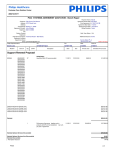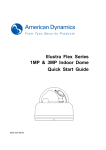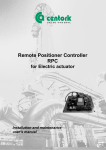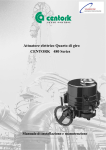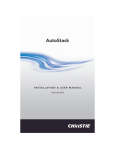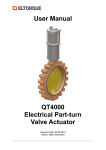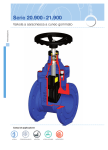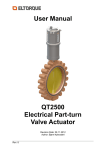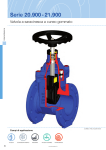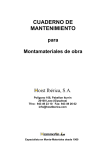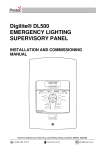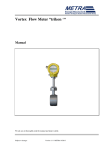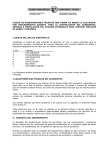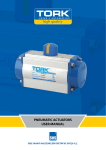Download 400 Centork Manual
Transcript
Multi-turn electric actuator 400, 410, 401 and 411 series Installation and maintenance User manual INDEX 1. 2. 3. CENTORK ELECTRIC ACTUATORS: INTRODUCTION .......................................................................4 SAFETY INSTRUCTIONS.......................................................................................................................4 TRANSPORT AND STORAGE ...............................................................................................................5 3.1 Transport..............................................................................................................................................5 3.2 Storage and commissioning.................................................................................................................5 4. CONDITIONS OF SERVICE FOR ELECTRIC ACTUATORS ................................................................7 4.1 Electric actuator: Main description and purpose..................................................................................7 4.2 Temperature range ..............................................................................................................................7 4.3 Actuator and motor duty service ..........................................................................................................7 4.4 IP protection degree.............................................................................................................................7 4.5 Painting and protection against corrosion............................................................................................7 5. MOUNTING TO THE VALVE ..................................................................................................................8 5.1 Pre-Installation Inspection....................................................................................................................8 5.2 Output size ...........................................................................................................................................8 5.3 Output type...........................................................................................................................................8 5.4 Mounting: .............................................................................................................................................8 6. ELECTRIC CONNECTIONS ...................................................................................................................9 6.1 Wiring diagram (electric manoeuvre) ...................................................................................................9 6.2 Terminal plan and wiring......................................................................................................................9 7. MANUAL OPERATION .........................................................................................................................11 8. SETTING and preliminary test...............................................................................................................12 8.1 Switching and signalling unit..............................................................................................................12 8.2 Actuator and valve (Sense of rotation) ..............................................................................................13 8.3 Motor and power supply (Sense of rotation)......................................................................................13 8.4 Closed position limit switch setting ....................................................................................................13 8.5 Open position limit switch setting.......................................................................................................14 8.6 Torque switching setting ....................................................................................................................14 8.7 Mechanical position indicator setting (optional) .................................................................................15 8.8 Auxiliary microswitches setting (optional) ..........................................................................................15 8.9 Potentiometer POT setting (optional).................................................................................................15 8.10 4-20 mA transmitter TPS setting (optional) ....................................................................................16 9. MAINTENANCE.....................................................................................................................................17 9.1 Commissioning, after the star-up .......................................................................................................17 9.2 Maintenance for service.....................................................................................................................17 9.3 Electric actuator’s service life.............................................................................................................17 10. TECHNICAL SUPPORT........................................................................................................................17 11. SPARE part LIST...................................................................................................................................18 APPENDIX 1: OUTPUT types..........................................................................................................................19 APPENDIX 2: FASTEN BOLTS (CLASS 8.8) ..................................................................................................21 APPENDIX 3: WIRING AND TERMINAL PLANS, LEGENDS AND SYMBOLS..............................................22 USER MANUAL Page 1 Page 2 USER MANUAL THIS USER MANUAL HAS BEEN DEVELOPED FOR ACTUATOR 400, 410, 401 and 411 SERIES ELECTRIC CAUTION Electric actuators are a high value devices. In order to prevent damage in their handling, setting and use it is essential to follow and observe all the points in this user manual, operate under actuators’ designated use, and observe health and safety rules, standards and directives, as other national regulations as well. Electric actuators must be handled with care and caution. IMPORTANT NOTE This work and the information it contains are property of CENTORK Valve Control S.L.. The information it contains will not be reproduced or disclosed, in whole or in part, without the prior written consent of CENTORK. The contents in this manual are subject to change due to the quality improvement without individual notice. USER MANUAL Page 3 1. CENTORK ELECTRIC ACTUATORS: INTRODUCTION The electric actuator is a device designed to be coupled to a general-purpose industrial valve, to carry out its movement. The movement is stopped by limit switching or by torque (thrust) switching. Other applications should be consulted CENTORK before. CENTORK is not liable for any possible damages resulting from use in other than designated applications. Such risk lies entirely on the user. 2. SAFETY INSTRUCTIONS The scope of this manual is to enable a competent user to install, operate, adjust and inspect a CENTORK electric actuator. These instructions must be observed, otherwise a safe operation of the actuator in no longer warrantee. When handling electric equipment, the health and safety standards (EN 60.204, 73/23/EEC directives) and any other national legislation applicable must be observed. As electric device, during electrical operation certain parts inevitably carry lethal voltages and currents (ELECTRICAL RISKS). Works on the electrical system or equipment must only be carried out by a skilled electrician himself or by specially instructed personnel, in accordance with the applicable electrical engineering rules, health and safety Directives and any other national legislation applicable. Electric actuators are powerful apparatus. A negligence handling might cause severe damages to valves, people, and actuator as well. Under no circumstances should any modification or alteration be carried out on the actuator as this could very well invalidate the conditions which the device was designed. Under operation, motor enclosure surfaces can reach high temperatures (up to 100ºC). Protection measures should be taken into acount in order to prevent people and goods from it. Page 4 USER MANUAL 3. TRANSPORT AND STORAGE 3.1 Transport − − − − − − − 3.2 CENTORK electric actuators must be transported in sturdy packing. During transport measures should be adopt in order to prevent impacts, hits. CENTORK delivers its actuators exwork. For transport purposes, handwheels are supplied separately. Hits or impacts against wall, surfaces or objects might cause severe damage on Electric actuator. In these cases, after such events, a technical inspection must be done by CENTORK technicians. Do not attach to the handwheel ropes or hooks to lift by hoist. The valve-actuator unit cannot be lifted/manipulated employing any lifting point of the actuator; Actuator has been designed and sized in order to motorize industrial valves, and withstand the forces and torque required. Covers have to be properly closed (Tight) and sealed. Cable entries on electrical connection cover must be sealed. Protection plug supplied by CENTORK are only adequate for storing in dry and ventilated places, for short period of time. In other conditions protection plug must be replaced with metallic plug sealed with PTFE tape. Each Actuator is delivered with a set of technical documentation (User manual, datasheet, diagrams…), which has to be carefully stored. Storage and commissioning Despite of their high degree of protection (IP67 as standard, and IP68 optional) condensation – presence of water- can occur inside the electric actuators by incorrect and negligent handling of the actuators. This may damage sensitive internal parts during the storage. This problem can be avoided by observing the following points. 3.2.1 Commissioning − Verify the actuator to insure correct model number, torque, operating speed, options and special components, voltage and enclosure type, and the actuator control before installation or use. It is important to verify that the actuator is appropriate for the requirements of the valve and the intended application. If there is any discrepancy, please contact with your local distributor, or CENTORK, to solve that discrepancy. Once the electric actuator has been set up, CENTORK decline any responsibility related to discrepancies. − Check (Visual inspection) in order to detect possible damages caused during transport or storage. Checking should include a visual inspection of electric compartment, and switching and signalling unit compartment. − Check that the painting work of the actuator is not been damaged. Retouch it when damaged. − Check that electrical connection cover, centronik frontal panel and switching and signalling unit cover and are correctly closed ant tight. Cable entries on electrical connection cover must be sealed. Protection plug supplied by CENTORK are only adequate for storing in dry and ventilated places, for short period of time. In other conditions protection plug must be replaced with metallic plug sealed with PTFE tape. − Each Actuator is delivered with a set of technical documentation (User manual, datasheet, diagrams…), which has to be carefully stored. − If damages like shocks, cracks, hits or others due to an improper handling, or humidity inside the equipment due to improper storage appear, contact CENTORK or your nearest distributor. USER MANUAL Page 5 3.2.2 Storage − Store in a clean, cool, dry and ventilated place. Protect against humidity from the floor. Use pallets, wooden frames, cage boxes or shelves. − Check that electrical connection cover and switching and signalling unit cover and are correctly closed ant tight. − Cable entries on electrical connection cover must be sealed. Protection plug supplied by CENTORK are only adequate for storing in dry and ventilated places, for short period of time. In other conditions protection plug must be replaced with metallic plug sealed with PTFE tape. − Do not store the actuator directly on the ground! − Cover it to protect it from dust and dirt. Cover the machined parts with suitable protection against corrosion. Do not employ plastic bags, as they can cause condensation. − Each Actuator is delivered with a set of technical documentation (User manual, datasheet, diagrams…), which has to be carefully stored. − For other storage conditions or, and long time periods (More than 5 months) contact to manufacturer. Page 6 USER MANUAL 4. CONDITIONS OF SERVICE FOR ELECTRIC ACTUATORS − − − PLC E/A E/A − Electric actuator is an apparatus or device formed by a electric motor, coupled to a main gearbox unit, which transmits motion and torque to valves. A switching and signalling unit, inside of Electric actuator, allows to provide torque and limit switching operation. Limit and torque switches must be included on the Electric manoeuvre in order to prevent overloads on valve and actuator which might cause a fatal damage on valve and actuator. Electric actuator must be controlled by a external electric cabinet with all elements needed (Transformer, contactors, relays, lamps, fuses…) Electric actuators actuators are provided with a declutchable manual override system in order to operate manually in case of emergency or fail of power supply. Electric actuator can be coupled directly to valve, or maybe, through gearbox units (Bevel, spur and worm gearboxes). E/A E/A Electric actuator: Main description and purpose − … 4.1 Power Signal The electric actuator is a device designed to be coupled to a general purpose industrial valve, to carry out its movement. The movement is stopped by limit switching or by torque (thrust) switching. Other applications should be consulted CENTORK before. CENTORK is not liable for any possible damages resulting from use in other than designated applications. Such risk lies entirely on the user. 4.2 Temperature range CENTORK Electric actuators work in a temperature range from -25ºC to +70ºC. 4.3 Actuator and motor duty service Electric actuator has been designed for valve motorization, which requires ON-OFF and inching (Modulating) duty service. − ON-OFF duty service: Electric actuator has been designed as S2-15 min (Three phases motor) or S2-10 min (Single phases motors) duty cycle at nominal torque, according to IEC standards: Nominal torque is rated to 50% of max tripping torque (100%), value marked on actuator nameplates. Higher nominal torques can reduce the actuator’s service life and S2 duty cycle. − Inching or modulating duty service: Electric actuators have been designed as S4-25%, at 1.200800 starts per hour, at nominal torque. Nominal torque is rated to 50% of max tripping torque (100%), value marked on actuator nameplates. Higher nominal torques can reduce the actuator’s service life and S4 duty cycle conditions. 4.4 IP protection degree − 4.5 CENTORK Electric actuators are designed in their standard version with IP67 (acc. EN 60.529) environmental protection although IP68 protection may be supplied on request. IP67 and IP68 protection degree is only guarantee employing proper protection plug and cable gland (For cable entries), according to IP degree (See chapter ELECTRIC CONNNECTIONS) . It is necessary to observe storing and maintenance rules written on TRANSPORT AND STORAGE chapter as well. Painting and protection against corrosion − − CENTORK has designed three protection degrees: Standard protection, P1 and P2. For technical details, consult CENTORK. CENTORK standard protection: Electric actuator is coated with a epoxy- two components primer (Film thickness depends on protection class selected, actuators are coated with intermediates primers) followed by a polyurethane component paint coat. The standard colour is blue RAL 5.003. Other colours are possible (Option). Other film thickness under request. USER MANUAL Page 7 5. MOUNTING TO THE VALVE 5.1 Pre-Installation Inspection − Verify the actuators nameplate to insure correct model number, torque, operating speed, voltage and enclosure type before installation or use. − It is important to verify that the output torque of the actuator is appropriate for the torque requirements of the valve and that the actuator duty cycle is appropriate of the intended application 5.2 Output size Check whether actuator output flange suits the flange of the valve to be driven. The latter should have been designed following the ISO5210 or ISO5211 standard, for standard application, or following the customer’s specifications, for special application. 5.3 Output type Check that the type of flange-coupling of the actuator suits the valve to be driven (diameters and lengths). Those manufactured as Standard at CENTORK follow the ISO5210/5211 standards. Types of output drive: − − − 5.4 Output type A: If not otherwise specified in the order, it is supplied blank. The thread must be machined according to the stem of the valve to be driven. For the dismounting and machining of this type of output, see Appendix . Output type A models can withstand axial loads and torque Output type B0, B1, B2, C: It is supplied machined to the dimensions stated in the ISO 5210/5211 or DIN 3338 standard. Output type B and C models cannot withstand axial loads. Output type B3, B4: It is supplied blank. For the dismounting and machining of this type of output, see Appendix. Mounting: − Check size and the type of output match the valve to be driven. − Degrease the mounting surfaces at actuator and valve thoroughly. − Slightly grease the input shaft of the valve to be driven. − Fit the actuator into the valve. In the event of a threaded output (type A), use the handwheel for turning the nut over the threaded stem. − Do not lift the actuator by the handwheel − The actuator may be mounted in any position. Before mounting, check proper orientation actuator and valve in order to simplify access to handwheel, switching and terminal compartments (Maintenance and start-up tasks). − Using ISO Class 8.8 quality bolts, fasten crosswise controlling the applied torque according to the table in Appendix Page 8 USER MANUAL 6. ELECTRIC CONNECTIONS CAUTION: Safety instructions on chapter 3 must be observed. Work on electrical system or equipment must only be carried out by skilled electrician. 6.1 Wiring diagram (electric manoeuvre) Electric actuator must be controlled by a external electric cabinet with all elements needed (Transformer, contactors, relays, lamps, fuses…) Wiring diagram should be designed according to electric actuator features. Electric actuator datasheet, supplied with the actuator, includes a PROPOSED WIRING DIAGRAM, delivered with other technical documentation. The following points should be observed: − − − − − − We recommend switching off the corresponding contactor/relay always directly by the limit or torque switch (opening and closing). Torque switches must be included on Electric/electric manoeuvre in order to protect actuator and valve from undesired overloads. Each valve manufacturer decides whether the switching off at both ends is made by torque switching or by limit switching. The maximum delay for switching off the motor with the signal of the torque or limit microswitch cannot exceed 40 ms. Torque and limit microswitches have 1NO+1NC contacts, only the NO same potential can be connected through both circuits. For different potentials, two double microswitches must be used. Torque microswitches signals are non-maintained signals, when motor NO NC stops after a over-torque condition torque signals may reset (Nonmaintained). Relays or another device must be employed (See wiring diagram) Capacitors for single-phase A.C. motors are delivered with electric actuators. They should be installed on electric cabinet (External). Each capacitor is dimensioned according to motor voltage and power. CENTORK actuators are provided with thermo-switches mounted in the windings of the motor (TRM). The protection of the motor is only achieved with a proper connection for these thermostats. Centork guarantee for the motor is not valid if this connection is not properly done. DC motor do not have thermo-switches on windings. Max current should be limited. Features of electric and electronic components listed on appendix. Wiring diagram are included on appendix: D0015X2 for A.C. three-phase, D0043X2 for A.C. single-phase, and D0042X3 for DC actuators 6.2 Terminal plan and wiring The electric connection diagram or terminal plan is depicted on Electric actuator datasheet, supplied with the actuator, and it can be found printed on a label inside of electrical compartment cover. − Open the electrical cover. Feed the cable(s) through the cable glands. Fix proper cable glands according to IP67 or IP68 protection degree. A) Electric actuator with Plug-socket connectors with screws − − Unscrew the attachment plate from the connection cover. With a suitable screwdriver, connect the cables for the control signals according to the electric connection diagram. USER MANUAL Page 9 B) Electric actuator with Terminals connection With a suitable screwdriver (SD 0,6x3,5 DIN 5264-A), connect the cables for the control signals according to the electric connection diagram. − Connect the internal earth cable terminal connection cover (M5 screw hole). − Connect the external earth cable terminal − Once you have checked that the connections have been properly carried out, close the connection cover and check the proper connection, the state of the o-ring seal and the proper installation of the latter, greasing it slightly. Fasten the 4 screws crosswise. to the earth connection located inside of electric to the earth connection terminal (See picture) Once you have checked that the connections have been properly carried out, close the connection cover and check the proper connection, the state of the o-ring seal and the proper installation of the latter, greasing it slightly. Fasten the 4 screws crosswise. Page 10 USER MANUAL 7. MANUAL OPERATION CENTORK actuators are fitted with a handwheel for the manual actuation of the valve. In the case of simultaneous motorised and manual working, the motorised one will always be the preferential one, “motor priority”. Once the handwheel has been engaged is not possible to disengage, the override engagement lever returns automatically to motor position when the motor is operated. Do not press the lever when motor is running. Procedure of engagement of manual operation: − Turn the changeover lever 20º clockwise while slightly turning the handwheel. − When you notice an increase in the resistance of the wheel, the manual control is engaged. − Run the valve in the desired direction. Standard sense of rotation is clockwise to close. For greater operating speed you can connect any powertool, pneumatic or electric, to the hand-wheel shaft. The maximum speed allowed is 150 rpm. Motor (Electric) operation mode When motor starts, system releases automatically (Lever returns) USER MANUAL Manual operation mode Push to engage manual operation Page 11 8. SETTING AND PRELIMINARY TEST Safety rules and standard should be observed (See SAFETY INSTRUCTIONS chapter). Work on electrical system or equipment must only be carried out by skilled electrician. − − − Setting and preliminary test can only be done when finished the wiring and mounting on valve. Electric manoeuvre (Electric cabinet) and devices should be ready and checked. Both the torque and the limit switches setting must be carried out in accordance with the characteristics of the valve to be driven. Each valve manufacturer decides whether the switching off at both ends is made by torque switching or by limit switching. If actuator has been supplied already assembled onto the valve by valve manufacturer, the settings made originally by the manufacturer should NOT be modified on site without the authorisation of the latter, otherwise, serious damage may be caused both to the valve and to the actuator. CENTORK recommend to move the valve to an intermediate position manually, -via handwheel device- (according to section 6) in order to execute the test routines descried below, avoiding problems due to incorrect routines or user’s mistakes. Just when user finishes a setting routine, covers must be closed, checking their O-ring (Sealing) ! 8.1 Switching and signalling unit Page 12 USER MANUAL 8.2 8.3 Actuator and valve (Sense of rotation) Electric actuator and valve sense of rotation must be the same. Electric actuator sense of rotation criteria is CLOCKWISE TO CLOCK. Sense of rotation is critical for many components (Microswitches, potentiometer,4-20 mA transmitter). A correct operation cannot be warranty in case of different sense of rotation valve/actuator) − Operate the Electric actuator via handwheel (See Manual operation chapter). − Check that running the handwheel clockwise, valve moves to close. If the turn direction is not correct, stop immediately and verify. Movement CLOCKWISE Motor and power supply (Sense of rotation) When running to close, check that U shaft turns in clockwise rotation sense (See picture). At the same time electric actuator output shaft should turn in clockwise sense of rotation as well. It this does not happen, stop immediately!, check: − − − 8.4 CLOSE For three-phase A.C. motors: Check that U-V-W phase sequence (Main voltage supply) is correct. Notice that U-V-W phases are wired to 1-2-3 motor contacts or terminals. Change two phases U-V-W on terminal blocks (e.g. U and V) and try it again. For single-phase A.C. motors: Verify the wiring (See figure) For DC motors: Check polarity on terminals!. Closed position limit switch setting − − PUSH OPERATION − − − PUSH Manually turn the valve to the desired CLOSED position. ER Disengaged PUSHER SHAFT: With a suitable ER screwdriver press the ‘PUSHER’ selector 3 mm and turn it 45º, ensure that it does not return to its original height (See figure 8.4.1) Switching and signalling Note: Pusher shaft allow to engage/disengage the Switching and signalling unit engaged to actuator. unit disengaged switching and signalling unit from Electric actuator gears. (Figures 8.4.1 and 8.4.2) Turn U spindle clockwise (Figure 8.4.3) until Z spindle turns Counter-clockwise (At this moment FRC microswitch triggers). Just before FRC microswitch was tripped, Z red arrow should be pointed to vertical: When Z spindle (Red arrow) turns to left the FRC microswitch is tripped. If, by accident, it has been carried on turning past the tripping of the FRC microswitch, turn spindle U in the opposite direction (counter-clockwise) until the Z spindle returns vertical (Figure 8.4.5) SETTING CLOSE CLOSE OPERATION SETTING CLOSE Movement Movement Movement Movement Movement USER MANUAL Page 13 − ENGAGE PUSHER SHAFT: Turn back selector ‘PUSHER’. Check that the shaft goes back to its initial position (Figure 8.4.2). This point is fundamental for the correct setting of the limit switches: Ensure that PUSHER shaft is correctly engaged. NOTE: For greater speed in long runs, small electric or pneumatic screwdriver can be used. 8.5 Open position limit switch setting − − − − − Manually turn the valve to the desired OPEN position. Disengaged PUSHER SHAFT: With a suitable screwdriver press the ‘PUSHER’ selector 3 mm and turn it 45º, ensure that it does not return to its original height (See figure 8.4.1) Turn A spindle Counter-clockwise (Figure 8.5.1) until B spindle turns clockwise (At this moment FRA microswitch triggers). Just before FRA microswitch was tripped, B red arrow should be pointed to vertical: When B spindle (Red arrow) turns to right the FRA microswitch is tripped. If, by accident, it has been carried on turning past the tripping of the FRA microswitch, turn spindle A in the opposite direction (clockwise) until the B spindle returns to vertical. Figure 8.5.3) ENGAGE PUSHER SHAFT: Turn back selector ‘PUSHER’. Check that go back to its initial position (Figure 8.4.2). This point is fundamental for the correct setting of the limit switches: Ensure that PUSHER shaft is correctly engaged. OPEN OPEN OPEN Movement Movement Movement Movement Torque switching setting CENTORK Electric actuators leave the factory tested and set for its Max. Torque (100%), as standard. Adjustment torque range is 60% up to 100% of Max. Torque rated on nameplates. Guarantee is not valid if the user exceeds this range (60%-100%), or if torque microswitches are not employed. Torque mechanism design Torque mechanism always acts as soon as actuator output torque exceeds the value set (Torque setting) It is used as protection throughout the whole valve travel and during the limit switch tripping. It also remains active during manual operation, thereby protecting the valve from any torque excess caused by the handwheel. 70% % 80 60% 60% G FPA T S ET FPC IN 60% 70% G E OR 100% QU G % 80 FPC % 80 100% QU T − SET TI N % 90 FPA OR T E % T QU 90 % 90 100% Tor que To rq ue Tor que OR 70% 8.6 E FPA S ET TI N FPC When torque on valve shaft exceeds the value set, e.g. running to close, shaft T turns to the right (Pointing to FPC), at the same time central SHAFT releases (See figures 8.6.1 and 8.6.2). FPC microswitch is tripped. Automatically, or when actuator starts running to opposite direction, mechanism returns or resets. Notice that central SHAFT latches again. (Figure 8.6.3) Page 14 USER MANUAL 60 0% 70 % % % 80 90% 60% 70 ue % % 90 8.7 Using a No.17 wrench, turn the P Torque regulator or Torque Limit Device until the desired torque matches with the arrow S on the dial. (Figures 8.6.4 and 8.6.5) To rq u e − Movement 10 Torque setting Procedure: 80% 100% r To q Mechanical position indicator setting (optional) Limit switches must be set before! Mechanical Position Indication dial turns between CLOSE and OPEN position depending on the actuator model and valve stroke. This is achieved with the addition of a suitable gearing according to the number of turns per valve stroke. If the latter varies, the gearing must be changed. Procedure: 8.8 Run actuator to the CLOSED position. − Unscrew the bolt and turn the dial with the symbol (CLOSED) until it matches with the mark ◄ on cover. − Run actuator to the OPEN position, and proceed exactly with disc containing OPEN symbol. − Screw the bolt Auxiliary microswitches setting (optional) − − − − − 8.9 − When actuator is fitted with a mechanical position indicator, remove its discs with a screwdriver. Run the actuator to the position needed to set auxiliary microswitch AUX1 With a No. 2 Allen key loosen the bolt in the cam corresponding to the auxiliary microswitch AUX1. Turn this cam until it triggers or trips the microswitch AUX1. Work the actuator in both directions, checking that the microswitch AUX1 correctly switches. Repeat points 2 to 4 for auxiliary microswitch AUX2, and AUX3. − Check that the bolts in each cam are tightened and do not allow the shift of the cam over the cam spindle. − If the actuator was fitted with a mechanical position indicator, reinstall it. Potentiometer POT setting (optional) Limit switches must be set before! Potentiometer is selected according to valve stroke. A suitable gearing unit reduce valve stroke (Number of turns) to less than one turn, this movement is measured by potentiometer located on switching and signalling unit. − − − − − Run the actuator to the CLOSED position. With a suitable screwdriver, turn the spindle (W) of the potentiometer POT, counter-clockwise, to its top end. Check that potentiometer value is 0 Ohms. Run the actuator to the OPEN position. Check that potentiometer value reaches its maximum (Ohms) Movement POT W Precision potentiometer CAUTION: The potentiometer is a high precision electromechanical device and should be handled carefully. It is necessary to use a suitable screwdriver for its setting. USER MANUAL Page 15 8.10 4-20 mA transmitter TPS setting (optional) − − − Limit switches must be set before. 4-20 mA transmitter are selected according to valve stroke. A suitable gearing unit reduce valve stroke (Number of turns) to less than one turn, this movement is measured by potentiometer, and converted to current signal by TPS transmitter. If valve stroke changes, TPS may not work properly. 4-20 mA TPS for standard versions: Different configurations are possible: Two wires, three wires and four wires modes. Procedure: − Run the actuator to the CLOSED position (sensor in minimum signal). − With a suitable screwdriver, turn the spindle (W) of the potentiometer POT, counter-clockwise, to its top end. − Adjust the output current with the ZERO (F) trimmer potentiometer until its reading is close to 4 mA − Run the actuator to the OPEN position (sensor in maximum signal). − Adjust the output current with the SPAN (D) trimmer potentiometer until its reading is close to the maximum current of 20mA. − Run the actuator back to the CLOSED position and check that the minimum current is 4 mA. If this is not the case, repeat points 2, 3, 4 and 5 until optimum adjustment values are reached. Movement POT W Precision potentiometer F shaft 4-20 mA TPS tranmitter4 mA ZERO potentiometer Movement ZERO Movement Movement SPAN D shaft 4-20 mA TPS tranmitter4 mA SPAN potentiometer CAUTION: The TPS electronic position transmitter is a high precision electronic device and should be handled carefully. It is necessary to use a suitable screwdriver for its setting. 8.10.1 Current (mA) output signal 4-Wires configuration 3-Wires configuration 24VDC Position Supply (mA) 24VDC Position Supply (mA) 2-Wires configuration 24VDC Position Supply (mA) (4-20 mA or 0-20 Ma) 8.10.2 Voltage (V) output signal: (0-10V or 2-10V) Page 16 4-Wires configuration 24VDC Supply Position (V) 3-Wires configuration 24VDC Supply Position (V) USER MANUAL 9. MAINTENANCE CAUTION: Safety instructions on nº2 chapter must be observed. CENTORK actuators are supplied greased from the factory for their lifetime, needing practically no maintenance. 9.1 Commissioning, after the star-up − − − − − − 9.2 Check for damage on paint caused by transport, assembly or handling and repair the damage carefully in order to ensure complete protection against corrosion. Make sure that all the o-ring seals are correctly mounted and that the cable glands are firmly fastened, and protection plug for cable entry not used have been replaced with metallic protection plug sealed with PTFE tape, in order to ensure the IP67, IP68 protection. Check that switching and signalling cover and connection cover screws are correctly fastened. Check the correct tightening of the bolts between the actuator and the valve. Check the correct greasing of the gear housing. The most important condition for reliable service of the CENTORK actuators is the fact of having carried out a correct commissioning and set-up procedure. Maintenance for service CENTORK recommends for a preventive maintenance programme. Approximately 3 months after commissioning and then every 9/12 months: − − − − − − 9.3 Check the correct tightening of the bolts between the actuator and the valve. Take advantage of each revision to check the proper tightening of the covers, of the handwheel lock and the external electric connection. Check cable entries. Visual inspection inside of switching and signalling, and electrical compartments. Contact with valve manufacturer in order to know about maintenance routines of valve. In the event of infrequent service, perform a test run every 6 months in order to ensure the availability of service of the actuator. Electric actuator’s service life − − − Electric actuator service life is rated to 20.000 cycles. Each cycle is formed by an opening manoeuvre (Valve close position to valve open position) and a closing manoeuvre (Valve open position to valve close position). 50 turns has been considered as standard valve stroke reference. 10. TECHNICAL SUPPORT Each actuator is supplied with a datasheet on A4 format. The following is included: − − − − The nameplates attached to the actuator. Electric actuador datasheet. The electric connection diagram for each actuator (also stuck inside the connections cover of the actuator). This electric actuator user manual. For any claim or information request, the SERIAL NUMBER included on this datasheet or on the Electric actuator nameplates should be used. Electric actuator manufacturer address: See on Manual covers. USER MANUAL Page 17 11. SPARE PART LIST 20 3 18 2 19 1 2 3 20 4 19 5 18 6 16 17 7 15 8 14 13 12 11 9 10 Electric actuators, 400 series Mark QTY Mark 1 Electric motor Description 1 12 TPS electronic position transmitter EEX ia 1 2 Handwheel and manual shaft subassembly 1 13 Heater 1 3 Override and declutch lever subassembly 1 14 Switching and signalling unit 1 4 Housing 1 15 Potentiometer subassembly 1 5 PTCS planetary subassembly 1 16 Gearing unit subassembly 1 6 Energy absorber springs subassembly 1 17 Visual indicator subassembly 1 7 External ground earth terminal 1 18 Switching and signalling unit cover 1 8 Actuator output flange 1 Terminal blocks with limit and torque switches 1 9 Motion measuring shaft subassembly 1 Plug-and-socket connector with limit and torque switches 1 Electric cover 1 10 Torque switching shaft subassembly 1 11 Torque regulator subassembly 1 Page 18 19 20 Description QTY USER MANUAL APPENDIX 1: OUTPUT TYPES OUTPUT TYPE A Size F-07 (ISO 5210) Disassembly: Employing a suitable tool, remove the retaining ring (3) which fix the removable bronze bush (1). Push in order to extract this piece. Assembly: Having machined the removable bush according to valve stem dimensions, refit the drive bus (1) into the output shaft bore, align the keyway (2) in its output shaft shape. Refit the retaining ring (3). Figure 1 OUTPUT TYPE A Size F-10/F-16/F-25 (ISO 5210) Disassembly: Push and press the removable bronze bush (2) in order to extract the cover (4), axial bearings (3) and removable bronze bush (2) Assembly: Having machined the removable bronze bush according to valve shaft, clean toughly this piece. Apply grease on axial bearings and discs (3). Assemble axial disc on removable bush (2), finally insert the cover (4). Check O-rings on cover. Apply grease on. Insert the removable bush on output type A base casting unit and output shaft, notice that dog coupling (Tooth) on bushing should match with actuator hollow output shaft (1).Verify O-ring (4). Figure 2 For maintenance, grease can be supply thought grease nipple (5). USER MANUAL Page 19 OUTPUT TYPE A Size F-14 (ISO 5210) Disassembly − Remove retaining ring (5) and unscrew the stop ring (4) employing a suitable tool. − Push and press the removable bronze bush (1) in order to extract it. Assembly: − Having machined the removable bush according to valve stem dimensions, refit the drive bus (1) into the output shaft bore (3), align the keyway (2) in its output shaft shape. − Screw the stop ring (4) employing a suitable tool. − Refit the retaining ring (5). Figure 3 OUTPUT TYPE B3 Size F-07/F-10/F-14/F-16/F-25 (ISO 5210) Disassembly: − − Employing a suitable tool, remove the retaining ring (4) which fix the removable steel bush (1). Push in order to extract this piece. Assembly: − − Having machined the removable steel bush according to valve stem dimensions, refit the drive bus (1) into the output shaft bore, align the keyway (2) in its output shaft shape. Refit the retaining ring (4). Figure 4 OUTPUT TYPE B0 Size F-10 / F-14 B0 output type is supplied, already machined, according to dimensions published in technical datasheets. Disassembly: − − Employing a suitable tool, remove the retaining ring (3) which fix the removable steel bush (1).Removable bush is located inside of output shaft (2) Push in order to extract this piece. Figure 5 Assembly: − − Having machined the removable steel bush according to valve stem dimensions, refit the drive bus (1) into the output shaft bore Refit the retaining ring (3). Page 20 USER MANUAL APPENDIX 2: FASTEN BOLTS (CLASS 8.8) FRICTION FACTOR BOLT LOW MEDIUM HIGH M4 4.2 6 8 M6 6.2 8.2 10 M8 15 21 24 M10 30 41 48 M12 49 68 85 M14 85 108 130 M16 130 165 200 M18 170 240 280 M20 240 340 410 M30 800 1150 1350 M36 1450 2050 2400 Torque values in N.m Steel bolts class 8.8 USER MANUAL Page 21 APPENDIX 3: WIRING AND TERMINAL PLANS, LEGENDS AND SYMBOLS. SYMBOL DESCRIPTION FPC: CLOSE torque microswitch. FPA: OPEN torque microswitch. FRC: CLOSE limit microswitch. (CLOSE end position) TECHNICAL FEATURES − − − − − − − Microswitch with silver contacts Type of contact: 1 NA / 1 NC Protection degree: IP67 Contacts: One fast acting 6 Mech. Life: 5.10 6 Electr. live: 5.10 Microswitch circuits NO+NC contacts, only the same potential can be connected through both circuits. For different potentials, two double microswitches must be used. AC DC Silver contacts 30V 125V 250V 30V 125V 250V Resistence 8A 6A 5A 2A 0.6A 0.4A FRA: OPEN limit microswitch. (OPEN end position) BLK: Movement signalling microswitch. As actuator output shaft rotates or moves, a cam acts and switches ON-OFF this BLK microswitch. − − − − − − Microswitch with silver contacts Type of contact: 1 NA (SPDT) Protection degree: IP67 Contacts: One fast acting 7 Mech. Life: 3.10 7 Electr. live: 3.10 Silver contacts Resistence POT: Precision Potentiometer − − − − − − − AC 30V 4A 125V 4A DC 250V 4A 30V 2A 125V 0.6A 250V 0.4A 10 kOhms (other values on request). Ohmic value tolerance : ±20% std. (±10% optional). Linearity : <1%. Power : 1W max. Turning angle : 340º± 5% Life : 106 cycles. Temperature range : -55ºC ¸ +125ºC.. Output Signal (current) : 2 wires :4....20 mA . 3 and 4 wires :0/4....20 mA. Output signal (voltage) (option) : 4 wires : 0-10 V. TPS: 4-20 mA transmitter Maximum supply :30 V. AC/DC Maximum resistance :600 Ohms 2 wires : R L max = Vcc − 18 (Ohms ) 2 ⋅ 10 −3 Precision : <1%. RLmin (voltage reference) : 1.2 kOhms. Temperature : -25ºC to +70ºC HT: Heater (space heater for anti-condensation) Page 22 − − Supply voltage : 220V A.C . or 24V DC. Power consumption : 5 - 7 W. USER MANUAL AUX1: Auxiliary switches for middle- valve positions − − − − − − Microswitch with silver contacts Type of contact: 1 NA (SPDT) Protection degree: IP67 Contacts: One fast acting 7 Mech. Life: 3.10 7 Electr. live: 3.10 Silver contacts Resistence M AC 30V 4A 125V 4A DC 250V 4A 30V 2A 125V 0.6A 250V 0.4A M1 A.C. motor (single and three-phase) − − − − Squirrel cage motor. Isolation class F. Main power supply: See motor nameplates. Main voltage supply tolerance: ±5% M1 DC. motor − − Main power supply: See motor nameplates. Main voltage supply tolerance: ±5% − The thermo-switches will open the circuit when the temperature of the windings reach 140 ºC and will close it when the temperature drops under 120 ºC. - + M TRM: M AC 250V / 50-60Hz Motor thermal protection via thermostatic switches (PTC thermistors on request). Cos ϕ =1 current 2A DC Cos ϕ =0.6 60V 42V 24V 1.2 A 1A 1.2A 1.8A For further technical information, consult CENTORK technical datasheet or contact directly with CENTORK. CENTORK address can be found printed on manual covers. USER MANUAL Page 23 DECLARATION OF CONFORMITY CENTORK VALVE CONTROL S.L. hereby declares under sole responsibility that the electric actuators, series listed below 1400. 1410. 1401. 1411. 1402. 1412. 1403. 1413. 1404. 1414. 1405. 1460. 1461. 1462. 1415. 1470. 1471. 1472. 1603. 1473. 1464. 1474. 1465. 1475 are designed and produced to be installed on industrial valves in compliance with the essential safety requirements of the following directives . 89/336/EC directive: Electromagnetic compatibility 73/23/EC directive: Low-voltage equipment 98/37/EC directive: Mechanical equipment-Machinery. Compliance with the Essential health and Safety Requirements has been assured by compliance with:, ISO 5210: 1.991 ISO 5211: 2.001 EN 292-1: 1.993 EN 292-2: 1.993 EN 50081-2:1994 EN 50082-2:1998 EN 61000-4:1999 EN 60204-1: 1.999 EN60034-1: 1.998 EN50178: 1.998 DIN VDE 0100: 1.997 DIN VDE 0530: 1982 Centork actuators covered by this Declaration must not be put into service until the equipment into which they are incorporated, has been declared in conformity with the provisions of the Machinery Directive. Lezo, 21 de Enero de 2.008 Francisco Lazcano -General manager(Centro fabricación y sede social) Centork Valve Control S.L. Pol ind. 110 Txatxamendi 24-26 Lezo 20.100 SPAIN CKCE006E01 EC declaration 400.doc Page 24 Pág. 1/1 USER MANUAL USER MANUAL Page 25 Page 26 USER MANUAL USER MANUAL Page 27 CENTORK Valve Control S.L. Pol. Ind. 110, Txatxamendi 24-26 LEZO 20.100 (SPAIN) Telf.: +34.943.31.61.37 Fax:: +34.943.22.36.57 Email: [email protected] http://www.centork.com 1497.MANE1400X001 Edition: 12.09

































